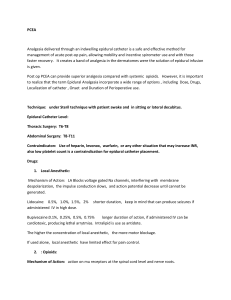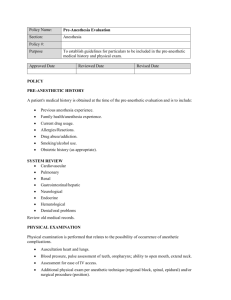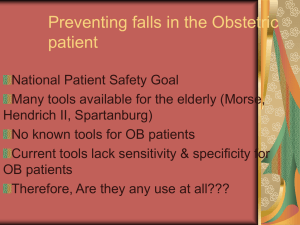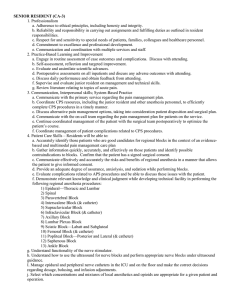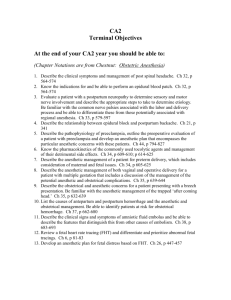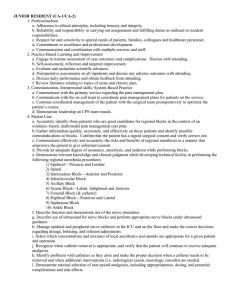Anesthesia Student Survival Guide Jesse Ehrenfeld, Richard Urman, and Scott Segal, editors
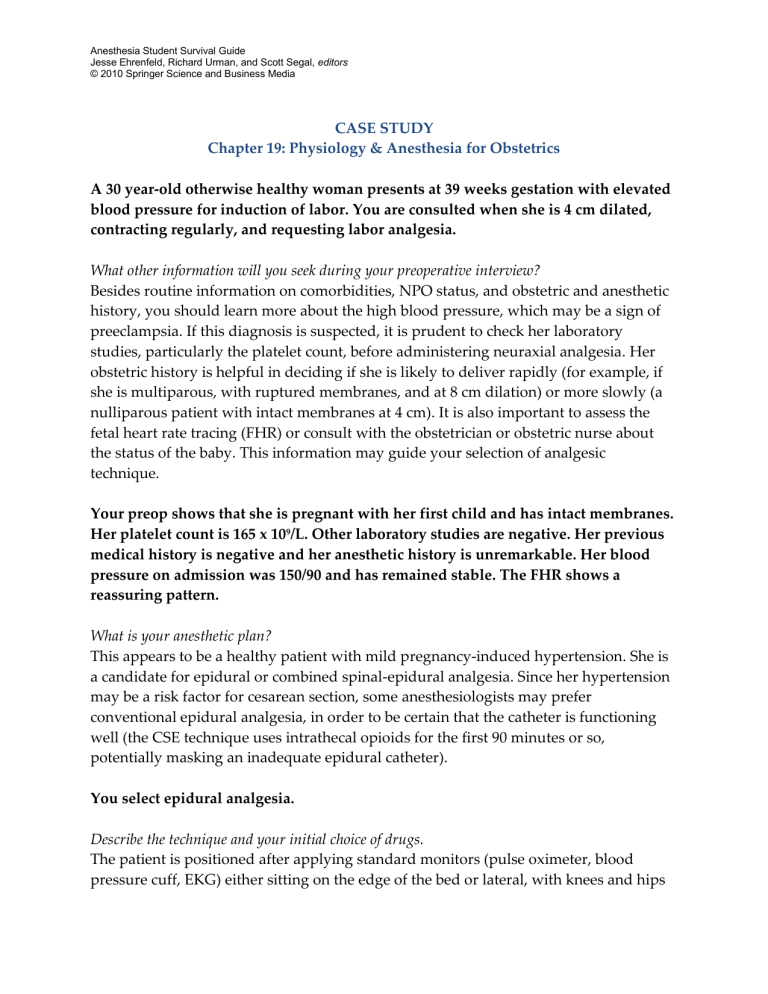
Anesthesia Student Survival Guide
Jesse Ehrenfeld, Richard Urman, and Scott Segal, editors
© 2010 Springer Science and Business Media
CASE STUDY
Chapter 19: Physiology & Anesthesia for Obstetrics
A 30 year-old otherwise healthy woman presents at 39 weeks gestation with elevated blood pressure for induction of labor. You are consulted when she is 4 cm dilated, contracting regularly, and requesting labor analgesia.
What other information will you seek during your preoperative interview?
Besides routine information on comorbidities, NPO status, and obstetric and anesthetic history, you should learn more about the high blood pressure, which may be a sign of preeclampsia. If this diagnosis is suspected, it is prudent to check her laboratory studies, particularly the platelet count, before administering neuraxial analgesia. Her obstetric history is helpful in deciding if she is likely to deliver rapidly (for example, if she is multiparous, with ruptured membranes, and at 8 cm dilation) or more slowly (a nulliparous patient with intact membranes at 4 cm). It is also important to assess the fetal heart rate tracing (FHR) or consult with the obstetrician or obstetric nurse about the status of the baby. This information may guide your selection of analgesic technique.
Your preop shows that she is pregnant with her first child and has intact membranes.
Her platelet count is 165 x 10 9 /L. Other laboratory studies are negative. Her previous medical history is negative and her anesthetic history is unremarkable. Her blood pressure on admission was 150/90 and has remained stable. The FHR shows a reassuring pattern.
What is your anesthetic plan?
This appears to be a healthy patient with mild pregnancy-induced hypertension. She is a candidate for epidural or combined spinal-epidural analgesia. Since her hypertension may be a risk factor for cesarean section, some anesthesiologists may prefer conventional epidural analgesia, in order to be certain that the catheter is functioning well (the CSE technique uses intrathecal opioids for the first 90 minutes or so, potentially masking an inadequate epidural catheter).
You select epidural analgesia.
Describe the technique and your initial choice of drugs.
The patient is positioned after applying standard monitors (pulse oximeter, blood pressure cuff, EKG) either sitting on the edge of the bed or lateral, with knees and hips
Anesthesia Student Survival Guide
Jesse Ehrenfeld, Richard Urman, and Scott Segal, editors
© 2010 Springer Science and Business Media flexed. The lower back is prepped and sterilely draped and the L3-4 (or L4-5 or L2-3) interspace is infiltrated with 1% lidocaine. The epidural needle is inserted into ligament with a slight cephalad angulation and then advanced slowly while checking for resistance to injection of saline or air in a syringe attached to the needle. When a loss of resistance is encountered (typically 4-7 cm from the skin), the catheter is threaded through the needle 3-5 cm into the epidural space, using the marks on the catheter and needle as a guide to depth, and secured with a sterile dressing and tape. A test dose of local anesthetic (with or without 1:200,000 epinephrine) is injected and the patient is asked for signs of intravascular injection (lightheadedness, tinnitus, perioral numbness) or intrathecal injection (immediate onset of profound numbness in the lower extremities). If negative, a loading dose of local anesthetic, often bupivacaine 0.0625-
0.125%, often mixed with 2 mcg/ml fentanyl, is injected in divided doses , periodically checking again for signs of intravascular injection.
How will you maintain analgesia once established?
Although there are numerous regimens, patient-controlled epidural analgesia (PCEA) is very popular. A background continuous infusion of 6 ml/hr, a demand dose of 6 ml, and a lockout between demands of 15 minutes, is a typical protocol. The patient is instructed to push the demand button if pain ensues and to have the anesthesiologist paged if relief does not occur after one or two demand doses. Periodic checks of the patient’s comfort and vital signs, the pump, and the FHR should continue even if your are not called!
After three hours, your are paged because the patient is experiencing discomfort in the perineal area. She has tried pushing the PCEA button.
How would you respond?
Sacral pain and the urge to push often herald the beginning of the second stage of labor.
Review of the most recent cervical exam with the obstetric nurse can help clarify the situation. A “top-up” dose of local anesthetic (5-10 ml of 0.125-0.25% bupivacaine and/or fentanyl (50-100 mcg), usually given with the back of the bed raised, is often effective.
The patient has reached full cervical dilation and begins pushing. Shortly thereafter, you are paged urgently because of decelerations noted on the FHR tracing.
What are your immediate steps?
First, assess the patient’s block and vital signs. Sometimes, hypotension following an additional dose of local anesthetic may precipitate FHR changes. If the BP has declined,
Anesthesia Student Survival Guide
Jesse Ehrenfeld, Richard Urman, and Scott Segal, editors
© 2010 Springer Science and Business Media give ephedrine, 10 mg, or phenylephrine, 40 mcg, and increase the rate of fluid administration. Put an oxygen mask on the patient and ensure that she is not positioned flat on her back (to avoid aorto-caval compression by the gravid uterus).
Vital signs are normal and the patient is comfortable, but the FHR tracing does not improve. The obstetrician wishes to perform a cesarean section.
How do you extend the epidural block for the operation?
Depending on the urgency of the situation, you administer lidocaine 2% with epinephrine or chloroprocaine, 3%, 10-20 ml in divided doses. Chloroprocaine has a faster onset but shorter duration of action, requiring frequent redosing, and is useful in emergent situations. The speed of onset and depth of the block is augmented by addition of bicarbonate, 1 ml per 10 ml of anesthetic. The goal is to obtain a T4 level
(numbness to the level of the nipples) within a few minutes. Vital signs should be monitored during administration, and fluids and ephedrine or phenylephrine given for hypotension. Fentanyl 50-100 mcg is another useful adjunct to deepen a lidocaine block.
